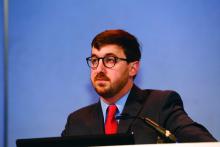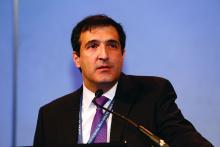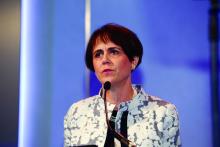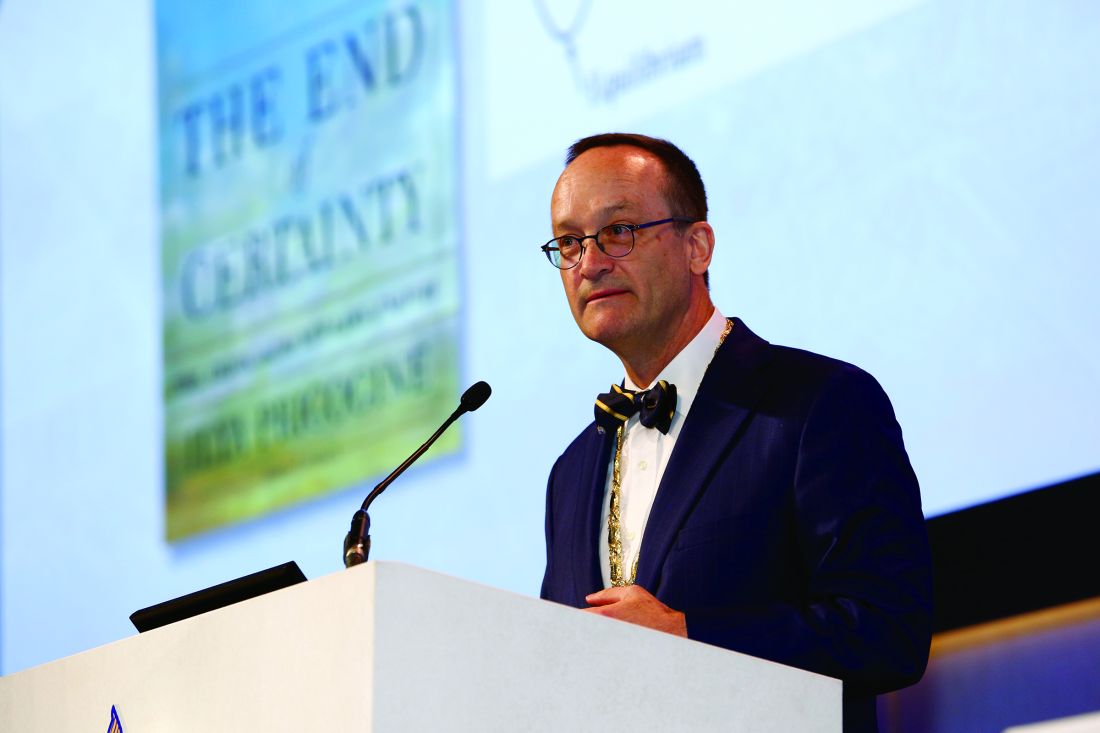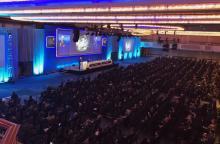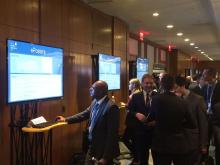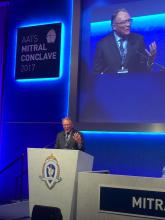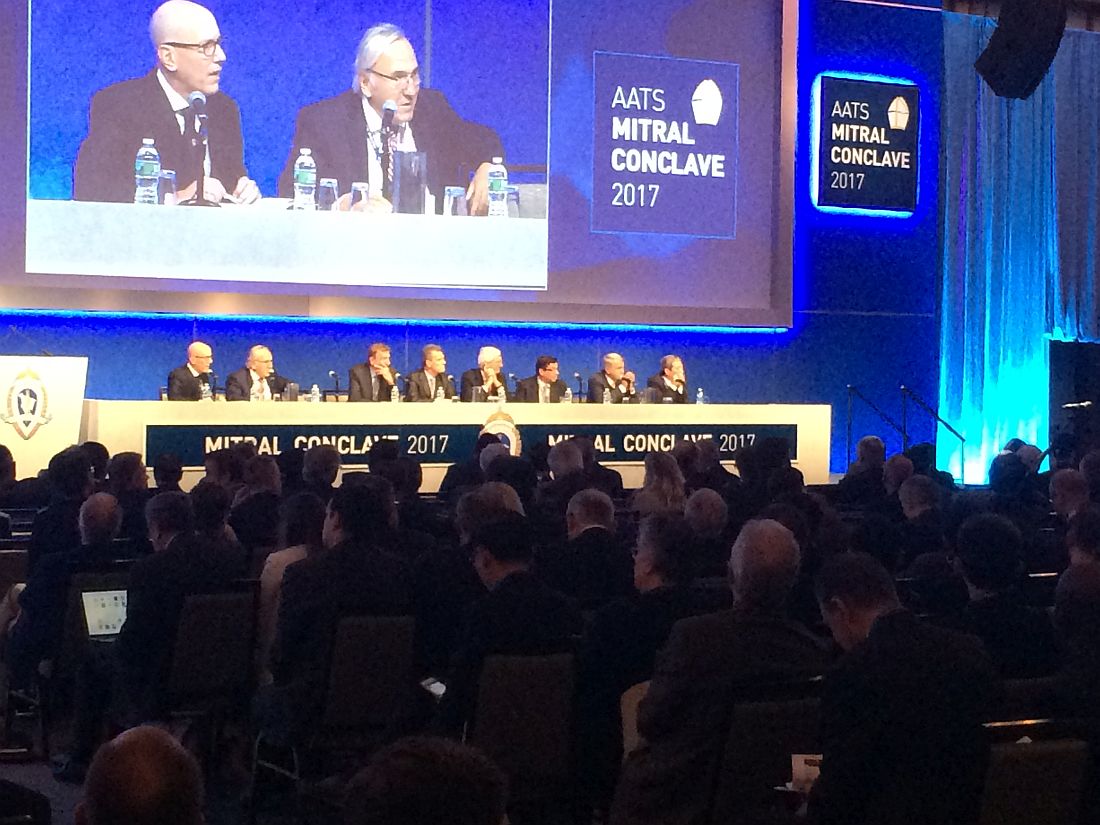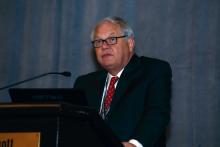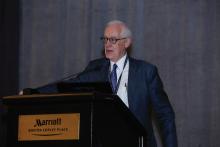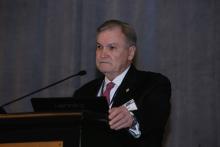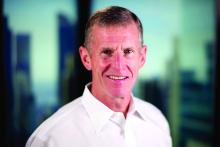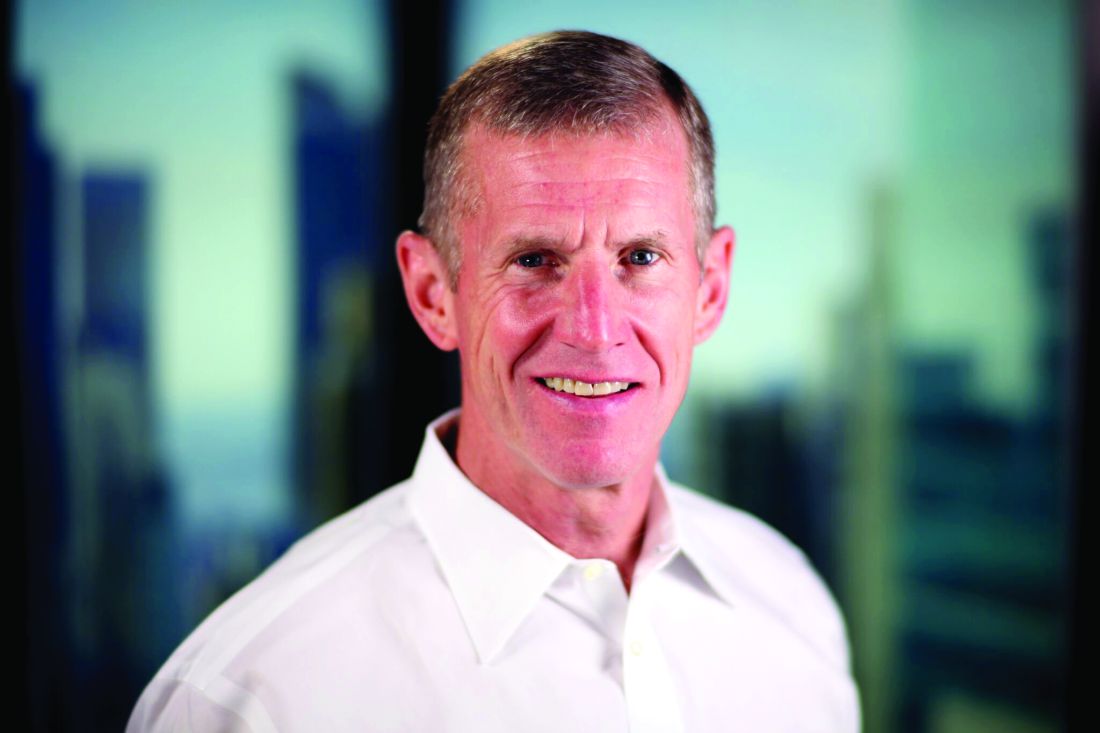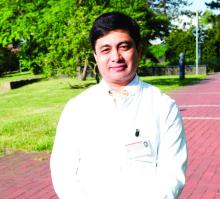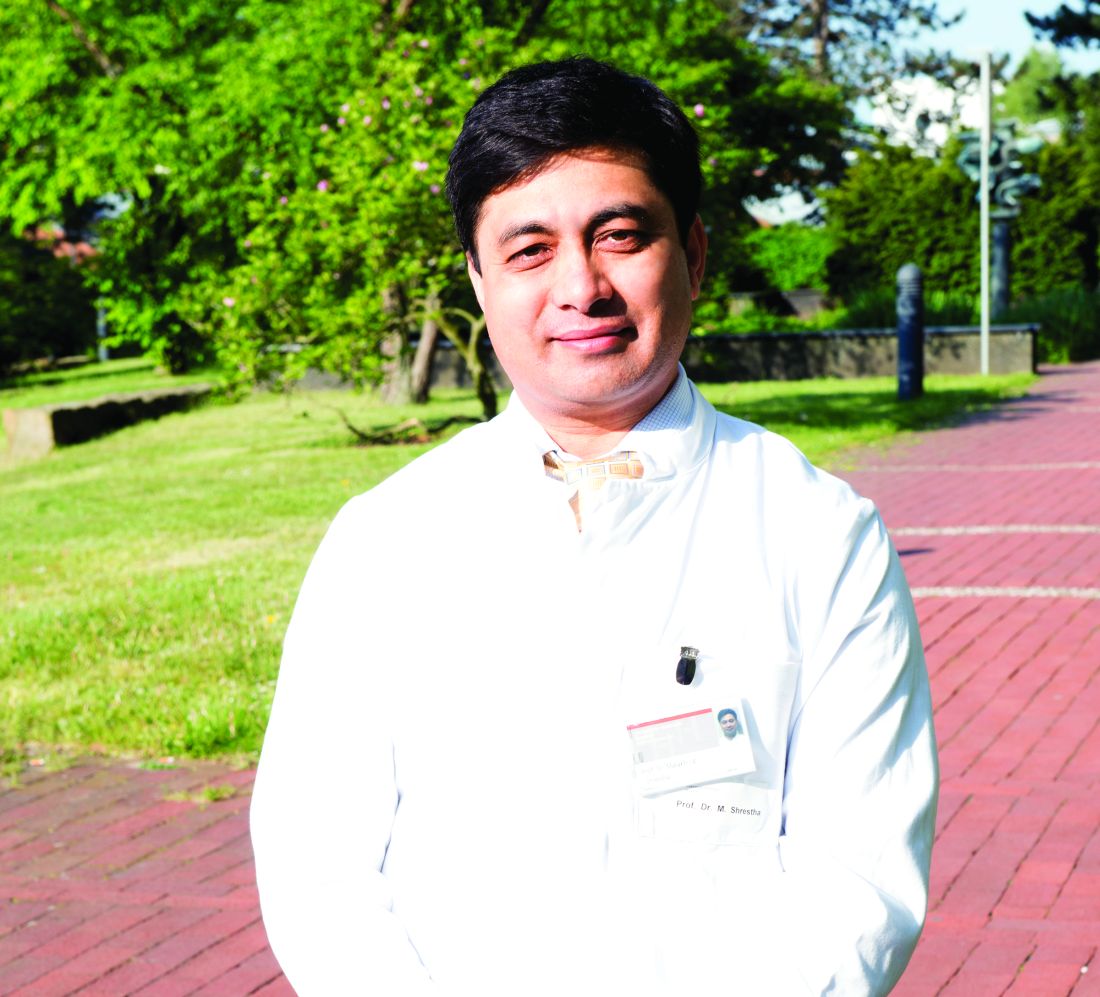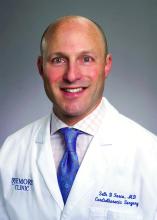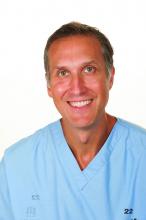User login
Monday’s Plenary tackled key issues
Presentations of the latest research in cardiothoracic surgery are the hallmark of the AATS Plenary session and this year’s session did not disappoint.
When repairing large paraesophageal hernias, transthoracic Belsey Mark IV fundoplication led to lower rates of leaks and reoperations than did the widely used laparoscopic Nissen fundoplication, according to a study presented by Danuel Laan, MD.
Dr. Laan, a resident at the Mayo Clinic in Rochester, Minn., and his colleagues compared outcomes after Belsey Mark IV fundoplication with those after laparoscopic Nissen fundoplication.
The researchers performed a retrospective review of prospectively collected data on all Mayo patients from 2002 to 2011 who underwent repair of a large paraesophageal hernia, defined as having more than 50% of the stomach within the chest. The analysis excluded patients who had already undergone a fundoplication.
Matching 118 Belsey fundoplication patients 1:1 with 118 Nissen fundoplication patients, the investigators compared the two groups for recurrence, need for reoperation, and perioperative outcomes. Nearly 30% of patients in the Belsey and Nissen groups were male. Mean age was 68.7 years and 69.8 years, respectively. Body mass index was 30.3 kg/m2 and 28.8 kg/m2, respectively.
Ten Belsey patients (8.4%) had a hernia recurrence, as did 19 Nissen patients (16.1%). Rates of leak and reoperation were greater in Nissen fundoplication patients than in Belsey patients. There were no leaks in the Belsey patients, compared with eight leaks (6.8%) in the Nissen patients, a statistically significant difference. Reoperation was necessary in 3 Belsey patients (2.5%), significantly fewer than the 11 Nissen patients (9.3%) who underwent reoperation.
Among 77 patients in each group followed for 5 years or less, there was no difference in symptoms. However, in 41 patients in each group followed for more than 5 years, symptoms were excellent or good in 85% of Belsey patients, compared with 56% of Nissen patients.
AATS: Surgical intervention relatively safe for AAOCA in youth
It’s relatively safe to surgically treat anomalous aortic origin of a coronary artery in children and adolescents, with essentially all patients cleared for full activity after 3 months, according to a study presented by Carlos M. Mery, MD.
Anomalous aortic origin of a coronary artery (AAOCA) is the second leading cause of sudden cardiac death (SCD) in young people, noted Dr. Mery of Texas Children’s Hospital.
He and his colleagues prospectively analyzed outcomes for 44 AAOCA patients who underwent surgical intervention as part of a standardized management program. The researchers included all AAOCA patients aged 2-18 years who underwent surgical intervention between December 2012 and April 2017 as part of the multidisciplinary Coronary Anomalies Program at Texas Children’s Hospital.
Surgical indications included an anomalous left coronary artery, ischemic symptoms, a positive nuclear perfusion test (NPT), or high-risk anatomy such as long intramural segment or ostial stenosis identified via CT angiography. Median patient age was 14 years.
Nine of the patients (20%) underwent surgery for an anomalous left coronary artery, with 32 patients (80%) receiving surgical intervention for an anomalous right coronary artery. A total of 34 surgical procedures (77%) were unroofing of intramural segments, 7 were coronary translocations (16%), and 2 were ostioplasties (4%).
There were no operative deaths. One patient required coronary artery bypass grafting after developing ischemia following a coronary translocation. Minor complications were seen in eight other patients (18%). One patient presented with a second episode of aborted sudden cardiac death 1 year after unroofing of an anomalous left coronary artery with a short intramural segment, and underwent successful coronary translocation and unroofing of a previously identified myocardial bridge.
At follow-up (median 2 years), 40 patients were asymptomatic (91%), while 4 patients had nonspecific chest pain (9%). Forty-one patients (93%) had returned to full activity, while 3 patients were waiting for their 3-month clearance to return to full activity.
Lobectomy can be done safely after concurrent chemotherapy and high-dose radiation in patients with resectable N2-positive stage IIIA non–small-cell lung cancer, according to study findings presented by Jessica S. Donington, MD.
Dr. Donington, of New York University, and her colleagues analyzed two prospective trials conducted by NRG Oncology, RTOG 0229 and RTOG 0839. Both trials’ primary endpoint was mediastinal node sterilization after concurrent chemotherapy and full-dose radiation and has been previously reported.
Dr. Donington and her fellow investigators specifically examined short-term surgical outcomes, given the significant controversy regarding the safety of resection after full-dose thoracic radiation.
In both trials, patients received weekly carboplatin and paclitaxel. Those in the 0229 trial underwent 61.2 Gy of radiation in 34 fractions, while patients in the 0839 trial underwent 60 Gy in 30 fractions. In addition, patients in the 0839 trial were randomized 2:1 to receive weekly panitumumab, an EGFR monoclonal antibody, with their induction therapy.
Surgical expertise was considered essential to this treatment strategy. Therefore, all surgeons were certified by RTOG prior to enrolling patients, and all patients were surgically evaluated before beginning induction therapy to determine resectability and appropriateness for trimodality therapy.
Of 125 eligible patients enrolled in the two trials, 93 patients (74%) underwent anatomic resection. A total of 77 patients underwent lobectomy, 8 underwent pneumonectomy, 6 underwent bilobectomy, and 2 patients had sleeve lobectomy. Medical contraindication and persistent nodal disease found during post-induction invasive staging were the most common reasons patients didn’t undergo resection.
Eighty-five of the 93 surgical patients had R0 resections (91%). Surgeons attempted 14 minimally invasive resections (15%), 2 of which uneventfully converted to open resection.
Just over one-quarter (28%) of patients suffered greater than Grade 3 adverse events (AEs) related to surgery, the majority of which were pulmonary in nature. The 30-day mortality rate was 4%, and all four deaths were linked to pulmonary AEs, including acute respiratory distress syndrome, bronchopleural fistula, pulmonary artery hemorrhage, and respiratory failure. Multivariable analysis for mortality identified the addition of panitumumab and use of an extended resection to be associated with an increased risk for operative mortality.
In the patients undergoing lobectomy, rates for greater than Grade 3 AEs and 30-day mortality were 26%, and 1.3%, respectively. Those rates are similar to rates reported for lobectomy without induction therapy in the National Inpatient Sample (NIS) and the STS General Thoracic Surgery Database over the same time period.
These two RTOG trials are the first to prospectively demonstrate that trimodality therapy with full-dose neoadjuvant radiation therapy is safe in a multi-institutional setting, Dr. Donington said.
Presentations of the latest research in cardiothoracic surgery are the hallmark of the AATS Plenary session and this year’s session did not disappoint.
When repairing large paraesophageal hernias, transthoracic Belsey Mark IV fundoplication led to lower rates of leaks and reoperations than did the widely used laparoscopic Nissen fundoplication, according to a study presented by Danuel Laan, MD.
Dr. Laan, a resident at the Mayo Clinic in Rochester, Minn., and his colleagues compared outcomes after Belsey Mark IV fundoplication with those after laparoscopic Nissen fundoplication.
The researchers performed a retrospective review of prospectively collected data on all Mayo patients from 2002 to 2011 who underwent repair of a large paraesophageal hernia, defined as having more than 50% of the stomach within the chest. The analysis excluded patients who had already undergone a fundoplication.
Matching 118 Belsey fundoplication patients 1:1 with 118 Nissen fundoplication patients, the investigators compared the two groups for recurrence, need for reoperation, and perioperative outcomes. Nearly 30% of patients in the Belsey and Nissen groups were male. Mean age was 68.7 years and 69.8 years, respectively. Body mass index was 30.3 kg/m2 and 28.8 kg/m2, respectively.
Ten Belsey patients (8.4%) had a hernia recurrence, as did 19 Nissen patients (16.1%). Rates of leak and reoperation were greater in Nissen fundoplication patients than in Belsey patients. There were no leaks in the Belsey patients, compared with eight leaks (6.8%) in the Nissen patients, a statistically significant difference. Reoperation was necessary in 3 Belsey patients (2.5%), significantly fewer than the 11 Nissen patients (9.3%) who underwent reoperation.
Among 77 patients in each group followed for 5 years or less, there was no difference in symptoms. However, in 41 patients in each group followed for more than 5 years, symptoms were excellent or good in 85% of Belsey patients, compared with 56% of Nissen patients.
AATS: Surgical intervention relatively safe for AAOCA in youth
It’s relatively safe to surgically treat anomalous aortic origin of a coronary artery in children and adolescents, with essentially all patients cleared for full activity after 3 months, according to a study presented by Carlos M. Mery, MD.
Anomalous aortic origin of a coronary artery (AAOCA) is the second leading cause of sudden cardiac death (SCD) in young people, noted Dr. Mery of Texas Children’s Hospital.
He and his colleagues prospectively analyzed outcomes for 44 AAOCA patients who underwent surgical intervention as part of a standardized management program. The researchers included all AAOCA patients aged 2-18 years who underwent surgical intervention between December 2012 and April 2017 as part of the multidisciplinary Coronary Anomalies Program at Texas Children’s Hospital.
Surgical indications included an anomalous left coronary artery, ischemic symptoms, a positive nuclear perfusion test (NPT), or high-risk anatomy such as long intramural segment or ostial stenosis identified via CT angiography. Median patient age was 14 years.
Nine of the patients (20%) underwent surgery for an anomalous left coronary artery, with 32 patients (80%) receiving surgical intervention for an anomalous right coronary artery. A total of 34 surgical procedures (77%) were unroofing of intramural segments, 7 were coronary translocations (16%), and 2 were ostioplasties (4%).
There were no operative deaths. One patient required coronary artery bypass grafting after developing ischemia following a coronary translocation. Minor complications were seen in eight other patients (18%). One patient presented with a second episode of aborted sudden cardiac death 1 year after unroofing of an anomalous left coronary artery with a short intramural segment, and underwent successful coronary translocation and unroofing of a previously identified myocardial bridge.
At follow-up (median 2 years), 40 patients were asymptomatic (91%), while 4 patients had nonspecific chest pain (9%). Forty-one patients (93%) had returned to full activity, while 3 patients were waiting for their 3-month clearance to return to full activity.
Lobectomy can be done safely after concurrent chemotherapy and high-dose radiation in patients with resectable N2-positive stage IIIA non–small-cell lung cancer, according to study findings presented by Jessica S. Donington, MD.
Dr. Donington, of New York University, and her colleagues analyzed two prospective trials conducted by NRG Oncology, RTOG 0229 and RTOG 0839. Both trials’ primary endpoint was mediastinal node sterilization after concurrent chemotherapy and full-dose radiation and has been previously reported.
Dr. Donington and her fellow investigators specifically examined short-term surgical outcomes, given the significant controversy regarding the safety of resection after full-dose thoracic radiation.
In both trials, patients received weekly carboplatin and paclitaxel. Those in the 0229 trial underwent 61.2 Gy of radiation in 34 fractions, while patients in the 0839 trial underwent 60 Gy in 30 fractions. In addition, patients in the 0839 trial were randomized 2:1 to receive weekly panitumumab, an EGFR monoclonal antibody, with their induction therapy.
Surgical expertise was considered essential to this treatment strategy. Therefore, all surgeons were certified by RTOG prior to enrolling patients, and all patients were surgically evaluated before beginning induction therapy to determine resectability and appropriateness for trimodality therapy.
Of 125 eligible patients enrolled in the two trials, 93 patients (74%) underwent anatomic resection. A total of 77 patients underwent lobectomy, 8 underwent pneumonectomy, 6 underwent bilobectomy, and 2 patients had sleeve lobectomy. Medical contraindication and persistent nodal disease found during post-induction invasive staging were the most common reasons patients didn’t undergo resection.
Eighty-five of the 93 surgical patients had R0 resections (91%). Surgeons attempted 14 minimally invasive resections (15%), 2 of which uneventfully converted to open resection.
Just over one-quarter (28%) of patients suffered greater than Grade 3 adverse events (AEs) related to surgery, the majority of which were pulmonary in nature. The 30-day mortality rate was 4%, and all four deaths were linked to pulmonary AEs, including acute respiratory distress syndrome, bronchopleural fistula, pulmonary artery hemorrhage, and respiratory failure. Multivariable analysis for mortality identified the addition of panitumumab and use of an extended resection to be associated with an increased risk for operative mortality.
In the patients undergoing lobectomy, rates for greater than Grade 3 AEs and 30-day mortality were 26%, and 1.3%, respectively. Those rates are similar to rates reported for lobectomy without induction therapy in the National Inpatient Sample (NIS) and the STS General Thoracic Surgery Database over the same time period.
These two RTOG trials are the first to prospectively demonstrate that trimodality therapy with full-dose neoadjuvant radiation therapy is safe in a multi-institutional setting, Dr. Donington said.
Presentations of the latest research in cardiothoracic surgery are the hallmark of the AATS Plenary session and this year’s session did not disappoint.
When repairing large paraesophageal hernias, transthoracic Belsey Mark IV fundoplication led to lower rates of leaks and reoperations than did the widely used laparoscopic Nissen fundoplication, according to a study presented by Danuel Laan, MD.
Dr. Laan, a resident at the Mayo Clinic in Rochester, Minn., and his colleagues compared outcomes after Belsey Mark IV fundoplication with those after laparoscopic Nissen fundoplication.
The researchers performed a retrospective review of prospectively collected data on all Mayo patients from 2002 to 2011 who underwent repair of a large paraesophageal hernia, defined as having more than 50% of the stomach within the chest. The analysis excluded patients who had already undergone a fundoplication.
Matching 118 Belsey fundoplication patients 1:1 with 118 Nissen fundoplication patients, the investigators compared the two groups for recurrence, need for reoperation, and perioperative outcomes. Nearly 30% of patients in the Belsey and Nissen groups were male. Mean age was 68.7 years and 69.8 years, respectively. Body mass index was 30.3 kg/m2 and 28.8 kg/m2, respectively.
Ten Belsey patients (8.4%) had a hernia recurrence, as did 19 Nissen patients (16.1%). Rates of leak and reoperation were greater in Nissen fundoplication patients than in Belsey patients. There were no leaks in the Belsey patients, compared with eight leaks (6.8%) in the Nissen patients, a statistically significant difference. Reoperation was necessary in 3 Belsey patients (2.5%), significantly fewer than the 11 Nissen patients (9.3%) who underwent reoperation.
Among 77 patients in each group followed for 5 years or less, there was no difference in symptoms. However, in 41 patients in each group followed for more than 5 years, symptoms were excellent or good in 85% of Belsey patients, compared with 56% of Nissen patients.
AATS: Surgical intervention relatively safe for AAOCA in youth
It’s relatively safe to surgically treat anomalous aortic origin of a coronary artery in children and adolescents, with essentially all patients cleared for full activity after 3 months, according to a study presented by Carlos M. Mery, MD.
Anomalous aortic origin of a coronary artery (AAOCA) is the second leading cause of sudden cardiac death (SCD) in young people, noted Dr. Mery of Texas Children’s Hospital.
He and his colleagues prospectively analyzed outcomes for 44 AAOCA patients who underwent surgical intervention as part of a standardized management program. The researchers included all AAOCA patients aged 2-18 years who underwent surgical intervention between December 2012 and April 2017 as part of the multidisciplinary Coronary Anomalies Program at Texas Children’s Hospital.
Surgical indications included an anomalous left coronary artery, ischemic symptoms, a positive nuclear perfusion test (NPT), or high-risk anatomy such as long intramural segment or ostial stenosis identified via CT angiography. Median patient age was 14 years.
Nine of the patients (20%) underwent surgery for an anomalous left coronary artery, with 32 patients (80%) receiving surgical intervention for an anomalous right coronary artery. A total of 34 surgical procedures (77%) were unroofing of intramural segments, 7 were coronary translocations (16%), and 2 were ostioplasties (4%).
There were no operative deaths. One patient required coronary artery bypass grafting after developing ischemia following a coronary translocation. Minor complications were seen in eight other patients (18%). One patient presented with a second episode of aborted sudden cardiac death 1 year after unroofing of an anomalous left coronary artery with a short intramural segment, and underwent successful coronary translocation and unroofing of a previously identified myocardial bridge.
At follow-up (median 2 years), 40 patients were asymptomatic (91%), while 4 patients had nonspecific chest pain (9%). Forty-one patients (93%) had returned to full activity, while 3 patients were waiting for their 3-month clearance to return to full activity.
Lobectomy can be done safely after concurrent chemotherapy and high-dose radiation in patients with resectable N2-positive stage IIIA non–small-cell lung cancer, according to study findings presented by Jessica S. Donington, MD.
Dr. Donington, of New York University, and her colleagues analyzed two prospective trials conducted by NRG Oncology, RTOG 0229 and RTOG 0839. Both trials’ primary endpoint was mediastinal node sterilization after concurrent chemotherapy and full-dose radiation and has been previously reported.
Dr. Donington and her fellow investigators specifically examined short-term surgical outcomes, given the significant controversy regarding the safety of resection after full-dose thoracic radiation.
In both trials, patients received weekly carboplatin and paclitaxel. Those in the 0229 trial underwent 61.2 Gy of radiation in 34 fractions, while patients in the 0839 trial underwent 60 Gy in 30 fractions. In addition, patients in the 0839 trial were randomized 2:1 to receive weekly panitumumab, an EGFR monoclonal antibody, with their induction therapy.
Surgical expertise was considered essential to this treatment strategy. Therefore, all surgeons were certified by RTOG prior to enrolling patients, and all patients were surgically evaluated before beginning induction therapy to determine resectability and appropriateness for trimodality therapy.
Of 125 eligible patients enrolled in the two trials, 93 patients (74%) underwent anatomic resection. A total of 77 patients underwent lobectomy, 8 underwent pneumonectomy, 6 underwent bilobectomy, and 2 patients had sleeve lobectomy. Medical contraindication and persistent nodal disease found during post-induction invasive staging were the most common reasons patients didn’t undergo resection.
Eighty-five of the 93 surgical patients had R0 resections (91%). Surgeons attempted 14 minimally invasive resections (15%), 2 of which uneventfully converted to open resection.
Just over one-quarter (28%) of patients suffered greater than Grade 3 adverse events (AEs) related to surgery, the majority of which were pulmonary in nature. The 30-day mortality rate was 4%, and all four deaths were linked to pulmonary AEs, including acute respiratory distress syndrome, bronchopleural fistula, pulmonary artery hemorrhage, and respiratory failure. Multivariable analysis for mortality identified the addition of panitumumab and use of an extended resection to be associated with an increased risk for operative mortality.
In the patients undergoing lobectomy, rates for greater than Grade 3 AEs and 30-day mortality were 26%, and 1.3%, respectively. Those rates are similar to rates reported for lobectomy without induction therapy in the National Inpatient Sample (NIS) and the STS General Thoracic Surgery Database over the same time period.
These two RTOG trials are the first to prospectively demonstrate that trimodality therapy with full-dose neoadjuvant radiation therapy is safe in a multi-institutional setting, Dr. Donington said.
Presidential address focused on learning and teams
Thoralf M. Sundt III, MD, titled his AATS Presidential Address, “Ancora Imparo: Always Learning,” to emphasize the fact that learning is at the core of team development and of dealing with a complex world.
The world once seemed simple, deterministic – a Newtonian world of individual performance, he said. But in fact, it is a complex, unpredictable world, where the solutions of a previous generation of leaders that relied on individual knowledge and authority no longer apply.
“Complex is not the same as complicated,” said Dr. Sundt. “A watch is complicated, but it is entirely predictable. Complexity is different.” Complex systems are composed of many diverse autonomous parts. They are independent, they are linked as a system, and most important – they adapt. They change in response to the environment and to their own component parts.
How they change depends critically on the nature of the interactions among those components, allowing them to demonstrate emergent properties. And they are unpredictable too, said Dr. Sundt.
This unpredictability poses problems, he added, pointing to the inevitability of systems failures in truly complex endeavors from nuclear power to petrochemical plants.
“The implication of this is that we must think beyond error prevention because we simply cannot prevent them all,” said Dr. Sundt. “That is why checklists alone will not solve our problems.” The focus, instead, he suggested, needs to be on “error management” in order to include detection and recovery.
This is all relevant to surgeons because “our world, our patients, the procedures we perform, and the institutions in which we performed them – are increasingly complex.” Therefore, “no matter how much we care, and no matter how much we try, accidents, mistakes and mishaps will occur – individual effort is not enough.”
But complexity is only half the problem, he said. “The other half is us.”
Dr. Sundt discussed two ways of thinking – fast and slow – with fast thinking grabbing on to patterns and making quick, seemingly intuitive decisions, such as those made by “experts,” and the slow following a deliberative and logical path.
Both types of thinking have their benefits and lacks, which points to how important it is to have access to each type in order to maximize success. Thus, he pointed out, there must be a focus on teams and on a diversity of views, because diversity increases the chances of finding the best good solution.
So diversity is necessary, but is it sufficient? Two other things are necessary, according to Dr. Sundt.
The first is synergy, which is the difference between another useless administrative meeting and an exciting, generative one during which everyone shares opinions, changes their views a bit, and collectively comes up with an entirely original idea.
“But the key to transforming a workgroup to a high-performing team is learning,” he said. “It is an active process that requires both cognitive, and - unfortunately for us task-oriented personalities – affective skills. The aim is to create a ‘learning organization’ – a culture that encourages learning through open interactions in a psychologically safe space.
“It is entirely within our power to change the nature of the interactions we have within our teams, and we can do it today. No hospital committee or departmental approval is required. You cannot solve all of the problems, but you do have an enormous impact on those individuals around you.”
As the leader of a team, “everyone is watching you.” he added.
Dr. Sundt concluded by pointing out that it is also extremely important to confront inevitable failure as a learning experience. “You must wring every drop of learning out of it,” he counseled. And ultimately, “trust your team - you need them. The patient needs them,” he concluded.
Thoralf M. Sundt III, MD, titled his AATS Presidential Address, “Ancora Imparo: Always Learning,” to emphasize the fact that learning is at the core of team development and of dealing with a complex world.
The world once seemed simple, deterministic – a Newtonian world of individual performance, he said. But in fact, it is a complex, unpredictable world, where the solutions of a previous generation of leaders that relied on individual knowledge and authority no longer apply.
“Complex is not the same as complicated,” said Dr. Sundt. “A watch is complicated, but it is entirely predictable. Complexity is different.” Complex systems are composed of many diverse autonomous parts. They are independent, they are linked as a system, and most important – they adapt. They change in response to the environment and to their own component parts.
How they change depends critically on the nature of the interactions among those components, allowing them to demonstrate emergent properties. And they are unpredictable too, said Dr. Sundt.
This unpredictability poses problems, he added, pointing to the inevitability of systems failures in truly complex endeavors from nuclear power to petrochemical plants.
“The implication of this is that we must think beyond error prevention because we simply cannot prevent them all,” said Dr. Sundt. “That is why checklists alone will not solve our problems.” The focus, instead, he suggested, needs to be on “error management” in order to include detection and recovery.
This is all relevant to surgeons because “our world, our patients, the procedures we perform, and the institutions in which we performed them – are increasingly complex.” Therefore, “no matter how much we care, and no matter how much we try, accidents, mistakes and mishaps will occur – individual effort is not enough.”
But complexity is only half the problem, he said. “The other half is us.”
Dr. Sundt discussed two ways of thinking – fast and slow – with fast thinking grabbing on to patterns and making quick, seemingly intuitive decisions, such as those made by “experts,” and the slow following a deliberative and logical path.
Both types of thinking have their benefits and lacks, which points to how important it is to have access to each type in order to maximize success. Thus, he pointed out, there must be a focus on teams and on a diversity of views, because diversity increases the chances of finding the best good solution.
So diversity is necessary, but is it sufficient? Two other things are necessary, according to Dr. Sundt.
The first is synergy, which is the difference between another useless administrative meeting and an exciting, generative one during which everyone shares opinions, changes their views a bit, and collectively comes up with an entirely original idea.
“But the key to transforming a workgroup to a high-performing team is learning,” he said. “It is an active process that requires both cognitive, and - unfortunately for us task-oriented personalities – affective skills. The aim is to create a ‘learning organization’ – a culture that encourages learning through open interactions in a psychologically safe space.
“It is entirely within our power to change the nature of the interactions we have within our teams, and we can do it today. No hospital committee or departmental approval is required. You cannot solve all of the problems, but you do have an enormous impact on those individuals around you.”
As the leader of a team, “everyone is watching you.” he added.
Dr. Sundt concluded by pointing out that it is also extremely important to confront inevitable failure as a learning experience. “You must wring every drop of learning out of it,” he counseled. And ultimately, “trust your team - you need them. The patient needs them,” he concluded.
Thoralf M. Sundt III, MD, titled his AATS Presidential Address, “Ancora Imparo: Always Learning,” to emphasize the fact that learning is at the core of team development and of dealing with a complex world.
The world once seemed simple, deterministic – a Newtonian world of individual performance, he said. But in fact, it is a complex, unpredictable world, where the solutions of a previous generation of leaders that relied on individual knowledge and authority no longer apply.
“Complex is not the same as complicated,” said Dr. Sundt. “A watch is complicated, but it is entirely predictable. Complexity is different.” Complex systems are composed of many diverse autonomous parts. They are independent, they are linked as a system, and most important – they adapt. They change in response to the environment and to their own component parts.
How they change depends critically on the nature of the interactions among those components, allowing them to demonstrate emergent properties. And they are unpredictable too, said Dr. Sundt.
This unpredictability poses problems, he added, pointing to the inevitability of systems failures in truly complex endeavors from nuclear power to petrochemical plants.
“The implication of this is that we must think beyond error prevention because we simply cannot prevent them all,” said Dr. Sundt. “That is why checklists alone will not solve our problems.” The focus, instead, he suggested, needs to be on “error management” in order to include detection and recovery.
This is all relevant to surgeons because “our world, our patients, the procedures we perform, and the institutions in which we performed them – are increasingly complex.” Therefore, “no matter how much we care, and no matter how much we try, accidents, mistakes and mishaps will occur – individual effort is not enough.”
But complexity is only half the problem, he said. “The other half is us.”
Dr. Sundt discussed two ways of thinking – fast and slow – with fast thinking grabbing on to patterns and making quick, seemingly intuitive decisions, such as those made by “experts,” and the slow following a deliberative and logical path.
Both types of thinking have their benefits and lacks, which points to how important it is to have access to each type in order to maximize success. Thus, he pointed out, there must be a focus on teams and on a diversity of views, because diversity increases the chances of finding the best good solution.
So diversity is necessary, but is it sufficient? Two other things are necessary, according to Dr. Sundt.
The first is synergy, which is the difference between another useless administrative meeting and an exciting, generative one during which everyone shares opinions, changes their views a bit, and collectively comes up with an entirely original idea.
“But the key to transforming a workgroup to a high-performing team is learning,” he said. “It is an active process that requires both cognitive, and - unfortunately for us task-oriented personalities – affective skills. The aim is to create a ‘learning organization’ – a culture that encourages learning through open interactions in a psychologically safe space.
“It is entirely within our power to change the nature of the interactions we have within our teams, and we can do it today. No hospital committee or departmental approval is required. You cannot solve all of the problems, but you do have an enormous impact on those individuals around you.”
As the leader of a team, “everyone is watching you.” he added.
Dr. Sundt concluded by pointing out that it is also extremely important to confront inevitable failure as a learning experience. “You must wring every drop of learning out of it,” he counseled. And ultimately, “trust your team - you need them. The patient needs them,” he concluded.
AATS Mitral Conclave Draws the Largest Crowd Ever
The fourth biennial the American Association for Thoracic Surgery (AATS) Mitral Conclave 2017 was attended by a large audience of cardiothoracic surgeons and other professionals from 67 countries on Thursday and Friday to hear the latest on repair and replacement of the mitral valve.
Conference chair David H. Adams, MD, of Mount Sinai Health System noted that this was the first time the AATS had directly managed the meeting. The conclave included more than 200 oral presentations and 207 e-posters.
The faculty included more than 70 international thought leaders in mitral valve repair, and the live sessions featured more than 200 lectures, abstracts, and video presentations. Twenty-two breakout sessions reported on more than 80 submitted abstracts.
Mastering videography skills also improves one’s minimally invasive skills, said Vinay Badhwar, MD, of West Virginia University. “To do mitral surgery robotically and do minimally invasive surgery, you have to become a videographer,” he said. The surgeon must also be engaged in carefully selecting his or her team, Dr. Badhwar added.
In seven different plenary sessions, international experts participated in panels that discussed management of complications and explored scenarios in which they would not intervene. A debate format modeled on the movie Thunderdome—“four men enter, one man leaves”—featured a spirited discussion on when to repair functional tricuspid regurgitation. Dr. Adams and Tirone E. David, MD, of Toronto General Hospital, took rather strident opposing views, with Dr. Adams advocating for repair. The goal, Dr. Adams said, is to provide normal tricuspid valve function for the long term. “We got aggressive because we were doing a lot of reoperations for tricuspid disease in patients who had mitral valve surgery,” Dr. Adams said.
One plenary roundtable tackled the subject of when to use mechanical valves instead of biological valves. “Has the pendulum swung too far away from mechanical valves and are there cases where mechanical valves should be the first choice?” Dr. Sundt, session chair, asked the panelists.
The panelists concurred that a patient’s individual needs would drive decision-making. Anelechi Anyanwu, MD, of Mount Sinai, said he’d be inclined to use a mechanical valve in a 25-year-old man with rheumatic mitral stenosis.* In younger patients, namely teenagers, valve selection depends on the activity level they’d pursue after surgery, said Pedro J. del Nido, MD, of Children’s Hospital Boston.
At the plenary on transcatheter mitral therapy, John Laschinger, MD, of the Food and Drug Administration, reviewed the approval process for new mitral devices. “It comes down to the benefit-risk determination where we look at the standard-of-care surgery and look to see if the device is an acceptable alternative – that is, if it is safer and more effective,” Dr. Laschinger said.
James S. Gammie, MD, of the University of Maryland, also reported on an analysis of 87,214 mitral procedures from the Society for Thoracic Surgeons database over the past 5 years. Among the revelations from this analysis are that 96.1% of procedures for leaflet prolapse involved annuloplasty and that 75.8% receive a bioprosthetic valve.
The plenary and breakouts also included seven different video sessions ranging from managing leaflet prolapse to adult congenital surgery and complex scenarios.
Robert A. Dion, MD, Genk, Belgium, delivered the Conclave Honored Lecture and received the Mitral Conclave Achievement Award. He talked about the operative team as a geese flight. “The geese flight is always a unit of hierarchy,” Dr. Dion said. “The figure of the geese flight is V and the chief chooses the lead goose for the capacity to fly high enough and fast enough.”
In the Honored Cardiology Lecture, Robert O. Bonow, MD, of Northwestern Memorial Hospital, explored clinical guidelines for mitral valve repair and replacement and their application in the clinic. “Both sets of guidelines in Europe and the United States make the clear point that is obvious to all of you but less so to cardiologists, that there are two forms of mitral valve disease: degenerative or primary, and functional, which is secondary,” he said. He called for thoracic surgeons to collaborate with their cardiology colleagues. “You and I have lots of work to do, not only in caring for our patients but also in starting to devise appropriate quality metrics, hopefully working together in a team-based approach,” Dr. Bonow said. “This is what gives the best patient care but also gives us the best recommendations for our policy issues. And I look forward to further enhancements from your field and mine as well.”
The AATS Mitral Conclave skips a year in 2018. Instead, New York will host the biennial AATS Aortic Symposium April 26–28 next year.
* CORRECTION: Dr. Anyanwu's remarks were corrected read "he’d be inclined to use a mechanical valve in a 25-year-old man with rheumatic mitral stenosis." 5/5/2017
The fourth biennial the American Association for Thoracic Surgery (AATS) Mitral Conclave 2017 was attended by a large audience of cardiothoracic surgeons and other professionals from 67 countries on Thursday and Friday to hear the latest on repair and replacement of the mitral valve.
Conference chair David H. Adams, MD, of Mount Sinai Health System noted that this was the first time the AATS had directly managed the meeting. The conclave included more than 200 oral presentations and 207 e-posters.
The faculty included more than 70 international thought leaders in mitral valve repair, and the live sessions featured more than 200 lectures, abstracts, and video presentations. Twenty-two breakout sessions reported on more than 80 submitted abstracts.
Mastering videography skills also improves one’s minimally invasive skills, said Vinay Badhwar, MD, of West Virginia University. “To do mitral surgery robotically and do minimally invasive surgery, you have to become a videographer,” he said. The surgeon must also be engaged in carefully selecting his or her team, Dr. Badhwar added.
In seven different plenary sessions, international experts participated in panels that discussed management of complications and explored scenarios in which they would not intervene. A debate format modeled on the movie Thunderdome—“four men enter, one man leaves”—featured a spirited discussion on when to repair functional tricuspid regurgitation. Dr. Adams and Tirone E. David, MD, of Toronto General Hospital, took rather strident opposing views, with Dr. Adams advocating for repair. The goal, Dr. Adams said, is to provide normal tricuspid valve function for the long term. “We got aggressive because we were doing a lot of reoperations for tricuspid disease in patients who had mitral valve surgery,” Dr. Adams said.
One plenary roundtable tackled the subject of when to use mechanical valves instead of biological valves. “Has the pendulum swung too far away from mechanical valves and are there cases where mechanical valves should be the first choice?” Dr. Sundt, session chair, asked the panelists.
The panelists concurred that a patient’s individual needs would drive decision-making. Anelechi Anyanwu, MD, of Mount Sinai, said he’d be inclined to use a mechanical valve in a 25-year-old man with rheumatic mitral stenosis.* In younger patients, namely teenagers, valve selection depends on the activity level they’d pursue after surgery, said Pedro J. del Nido, MD, of Children’s Hospital Boston.
At the plenary on transcatheter mitral therapy, John Laschinger, MD, of the Food and Drug Administration, reviewed the approval process for new mitral devices. “It comes down to the benefit-risk determination where we look at the standard-of-care surgery and look to see if the device is an acceptable alternative – that is, if it is safer and more effective,” Dr. Laschinger said.
James S. Gammie, MD, of the University of Maryland, also reported on an analysis of 87,214 mitral procedures from the Society for Thoracic Surgeons database over the past 5 years. Among the revelations from this analysis are that 96.1% of procedures for leaflet prolapse involved annuloplasty and that 75.8% receive a bioprosthetic valve.
The plenary and breakouts also included seven different video sessions ranging from managing leaflet prolapse to adult congenital surgery and complex scenarios.
Robert A. Dion, MD, Genk, Belgium, delivered the Conclave Honored Lecture and received the Mitral Conclave Achievement Award. He talked about the operative team as a geese flight. “The geese flight is always a unit of hierarchy,” Dr. Dion said. “The figure of the geese flight is V and the chief chooses the lead goose for the capacity to fly high enough and fast enough.”
In the Honored Cardiology Lecture, Robert O. Bonow, MD, of Northwestern Memorial Hospital, explored clinical guidelines for mitral valve repair and replacement and their application in the clinic. “Both sets of guidelines in Europe and the United States make the clear point that is obvious to all of you but less so to cardiologists, that there are two forms of mitral valve disease: degenerative or primary, and functional, which is secondary,” he said. He called for thoracic surgeons to collaborate with their cardiology colleagues. “You and I have lots of work to do, not only in caring for our patients but also in starting to devise appropriate quality metrics, hopefully working together in a team-based approach,” Dr. Bonow said. “This is what gives the best patient care but also gives us the best recommendations for our policy issues. And I look forward to further enhancements from your field and mine as well.”
The AATS Mitral Conclave skips a year in 2018. Instead, New York will host the biennial AATS Aortic Symposium April 26–28 next year.
* CORRECTION: Dr. Anyanwu's remarks were corrected read "he’d be inclined to use a mechanical valve in a 25-year-old man with rheumatic mitral stenosis." 5/5/2017
The fourth biennial the American Association for Thoracic Surgery (AATS) Mitral Conclave 2017 was attended by a large audience of cardiothoracic surgeons and other professionals from 67 countries on Thursday and Friday to hear the latest on repair and replacement of the mitral valve.
Conference chair David H. Adams, MD, of Mount Sinai Health System noted that this was the first time the AATS had directly managed the meeting. The conclave included more than 200 oral presentations and 207 e-posters.
The faculty included more than 70 international thought leaders in mitral valve repair, and the live sessions featured more than 200 lectures, abstracts, and video presentations. Twenty-two breakout sessions reported on more than 80 submitted abstracts.
Mastering videography skills also improves one’s minimally invasive skills, said Vinay Badhwar, MD, of West Virginia University. “To do mitral surgery robotically and do minimally invasive surgery, you have to become a videographer,” he said. The surgeon must also be engaged in carefully selecting his or her team, Dr. Badhwar added.
In seven different plenary sessions, international experts participated in panels that discussed management of complications and explored scenarios in which they would not intervene. A debate format modeled on the movie Thunderdome—“four men enter, one man leaves”—featured a spirited discussion on when to repair functional tricuspid regurgitation. Dr. Adams and Tirone E. David, MD, of Toronto General Hospital, took rather strident opposing views, with Dr. Adams advocating for repair. The goal, Dr. Adams said, is to provide normal tricuspid valve function for the long term. “We got aggressive because we were doing a lot of reoperations for tricuspid disease in patients who had mitral valve surgery,” Dr. Adams said.
One plenary roundtable tackled the subject of when to use mechanical valves instead of biological valves. “Has the pendulum swung too far away from mechanical valves and are there cases where mechanical valves should be the first choice?” Dr. Sundt, session chair, asked the panelists.
The panelists concurred that a patient’s individual needs would drive decision-making. Anelechi Anyanwu, MD, of Mount Sinai, said he’d be inclined to use a mechanical valve in a 25-year-old man with rheumatic mitral stenosis.* In younger patients, namely teenagers, valve selection depends on the activity level they’d pursue after surgery, said Pedro J. del Nido, MD, of Children’s Hospital Boston.
At the plenary on transcatheter mitral therapy, John Laschinger, MD, of the Food and Drug Administration, reviewed the approval process for new mitral devices. “It comes down to the benefit-risk determination where we look at the standard-of-care surgery and look to see if the device is an acceptable alternative – that is, if it is safer and more effective,” Dr. Laschinger said.
James S. Gammie, MD, of the University of Maryland, also reported on an analysis of 87,214 mitral procedures from the Society for Thoracic Surgeons database over the past 5 years. Among the revelations from this analysis are that 96.1% of procedures for leaflet prolapse involved annuloplasty and that 75.8% receive a bioprosthetic valve.
The plenary and breakouts also included seven different video sessions ranging from managing leaflet prolapse to adult congenital surgery and complex scenarios.
Robert A. Dion, MD, Genk, Belgium, delivered the Conclave Honored Lecture and received the Mitral Conclave Achievement Award. He talked about the operative team as a geese flight. “The geese flight is always a unit of hierarchy,” Dr. Dion said. “The figure of the geese flight is V and the chief chooses the lead goose for the capacity to fly high enough and fast enough.”
In the Honored Cardiology Lecture, Robert O. Bonow, MD, of Northwestern Memorial Hospital, explored clinical guidelines for mitral valve repair and replacement and their application in the clinic. “Both sets of guidelines in Europe and the United States make the clear point that is obvious to all of you but less so to cardiologists, that there are two forms of mitral valve disease: degenerative or primary, and functional, which is secondary,” he said. He called for thoracic surgeons to collaborate with their cardiology colleagues. “You and I have lots of work to do, not only in caring for our patients but also in starting to devise appropriate quality metrics, hopefully working together in a team-based approach,” Dr. Bonow said. “This is what gives the best patient care but also gives us the best recommendations for our policy issues. And I look forward to further enhancements from your field and mine as well.”
The AATS Mitral Conclave skips a year in 2018. Instead, New York will host the biennial AATS Aortic Symposium April 26–28 next year.
* CORRECTION: Dr. Anyanwu's remarks were corrected read "he’d be inclined to use a mechanical valve in a 25-year-old man with rheumatic mitral stenosis." 5/5/2017
Inaugural Innovation Summit Addressed CTS Creativity and Development
The first AATS Innovation Summit was launched on Saturday morning. The Summit was designed to assist cardiothoracic surgeons in developing new clinically applicable technology by giving them information on how to protect intellectual property, obtain funding, and conduct clinical trials. Attendees also got the latest updates on regulatory pathways and advice on building industry relationships needed to forge a novel product.
Pedro J. del Nido, MD, who was instrumental in coming up with the original idea for the Summit, introduced former AATS President W. Randolph Chitwood Jr., MD, who served as Program Director.
“The most fun part of this meeting,” Dr. Chitwood promised, would be the Commercialization Workshop at the end of the day “where we develop a fictitious product and carry it all the way to commercialization.”
Michael J. Mack, MD, a famous innovator in his own right, opened the didactic portion of the program by outlining the Summit Challenges.
“The whole field of cardiac surgery is moving to a catheter-based approach,” he declared.
He pointed out the tremendous growth in the invention of catheter-based products in the mitral regurgitation space. “The field is fertile with innovators,” he added.
In order to be innovative, he said, quoting what he called the Bavaria Rules, after Joseph E. Bavaria, MD, “You’ve got to have a vision; you’ve got to have a strategy; you need the tactics to implement that strategy, and at the end of the day, you have to execute that strategy.”
He concluded his talk saying, “Our field has a legacy of innovation. Our challenge is to adopt the tools to move that innovation field forward that our specialty has always been known for.”
He listed some of the major innovations in the cardiac space over the past 60+ years, from the beginning of aortic surgery, to mitral valve surgery, the Maze procedure, and even TAVR, pointing out that historically at least 10-20 years has been the lag time between the development of the innovation and its more-or-less widespread adoption, following the so-called S-curve.
The next stage of innovation is not starting from scratch, he said, but rather the recognition that the previous innovation can be improved upon, and the beginning of a new innovation S-curve at the peak of the old, a process of continual development and refinement.
Dr. Cox stressed that for innovation to be adopted, it couldn’t be overly complex, citing the Maze procedure for atrial fibrillation, which was highly superior to the alternatives for treating AF, but has still lagged behind pulmonary vein isolation, a much less effective, but much easier technique used by interventional cardiologists.
He showed data demonstrating that when it came to innovative techniques, cure rate effectively did not matter to adoption, compared to the level of complexity of the new procedure.
He added that it was important for any new innovation to not “get too far away” from nature and its lessons, and that it should not be too complex to be routinely trained for and adopted.
Dr. Cox concluded with an admonition to new innovators to “listen to what your peers say. They have ideas, experiences, and imaginations of their own.”
He added that “they may or may not have anything to say that will change your course, but you have to listen to them.”
The first AATS Innovation Summit was launched on Saturday morning. The Summit was designed to assist cardiothoracic surgeons in developing new clinically applicable technology by giving them information on how to protect intellectual property, obtain funding, and conduct clinical trials. Attendees also got the latest updates on regulatory pathways and advice on building industry relationships needed to forge a novel product.
Pedro J. del Nido, MD, who was instrumental in coming up with the original idea for the Summit, introduced former AATS President W. Randolph Chitwood Jr., MD, who served as Program Director.
“The most fun part of this meeting,” Dr. Chitwood promised, would be the Commercialization Workshop at the end of the day “where we develop a fictitious product and carry it all the way to commercialization.”
Michael J. Mack, MD, a famous innovator in his own right, opened the didactic portion of the program by outlining the Summit Challenges.
“The whole field of cardiac surgery is moving to a catheter-based approach,” he declared.
He pointed out the tremendous growth in the invention of catheter-based products in the mitral regurgitation space. “The field is fertile with innovators,” he added.
In order to be innovative, he said, quoting what he called the Bavaria Rules, after Joseph E. Bavaria, MD, “You’ve got to have a vision; you’ve got to have a strategy; you need the tactics to implement that strategy, and at the end of the day, you have to execute that strategy.”
He concluded his talk saying, “Our field has a legacy of innovation. Our challenge is to adopt the tools to move that innovation field forward that our specialty has always been known for.”
He listed some of the major innovations in the cardiac space over the past 60+ years, from the beginning of aortic surgery, to mitral valve surgery, the Maze procedure, and even TAVR, pointing out that historically at least 10-20 years has been the lag time between the development of the innovation and its more-or-less widespread adoption, following the so-called S-curve.
The next stage of innovation is not starting from scratch, he said, but rather the recognition that the previous innovation can be improved upon, and the beginning of a new innovation S-curve at the peak of the old, a process of continual development and refinement.
Dr. Cox stressed that for innovation to be adopted, it couldn’t be overly complex, citing the Maze procedure for atrial fibrillation, which was highly superior to the alternatives for treating AF, but has still lagged behind pulmonary vein isolation, a much less effective, but much easier technique used by interventional cardiologists.
He showed data demonstrating that when it came to innovative techniques, cure rate effectively did not matter to adoption, compared to the level of complexity of the new procedure.
He added that it was important for any new innovation to not “get too far away” from nature and its lessons, and that it should not be too complex to be routinely trained for and adopted.
Dr. Cox concluded with an admonition to new innovators to “listen to what your peers say. They have ideas, experiences, and imaginations of their own.”
He added that “they may or may not have anything to say that will change your course, but you have to listen to them.”
The first AATS Innovation Summit was launched on Saturday morning. The Summit was designed to assist cardiothoracic surgeons in developing new clinically applicable technology by giving them information on how to protect intellectual property, obtain funding, and conduct clinical trials. Attendees also got the latest updates on regulatory pathways and advice on building industry relationships needed to forge a novel product.
Pedro J. del Nido, MD, who was instrumental in coming up with the original idea for the Summit, introduced former AATS President W. Randolph Chitwood Jr., MD, who served as Program Director.
“The most fun part of this meeting,” Dr. Chitwood promised, would be the Commercialization Workshop at the end of the day “where we develop a fictitious product and carry it all the way to commercialization.”
Michael J. Mack, MD, a famous innovator in his own right, opened the didactic portion of the program by outlining the Summit Challenges.
“The whole field of cardiac surgery is moving to a catheter-based approach,” he declared.
He pointed out the tremendous growth in the invention of catheter-based products in the mitral regurgitation space. “The field is fertile with innovators,” he added.
In order to be innovative, he said, quoting what he called the Bavaria Rules, after Joseph E. Bavaria, MD, “You’ve got to have a vision; you’ve got to have a strategy; you need the tactics to implement that strategy, and at the end of the day, you have to execute that strategy.”
He concluded his talk saying, “Our field has a legacy of innovation. Our challenge is to adopt the tools to move that innovation field forward that our specialty has always been known for.”
He listed some of the major innovations in the cardiac space over the past 60+ years, from the beginning of aortic surgery, to mitral valve surgery, the Maze procedure, and even TAVR, pointing out that historically at least 10-20 years has been the lag time between the development of the innovation and its more-or-less widespread adoption, following the so-called S-curve.
The next stage of innovation is not starting from scratch, he said, but rather the recognition that the previous innovation can be improved upon, and the beginning of a new innovation S-curve at the peak of the old, a process of continual development and refinement.
Dr. Cox stressed that for innovation to be adopted, it couldn’t be overly complex, citing the Maze procedure for atrial fibrillation, which was highly superior to the alternatives for treating AF, but has still lagged behind pulmonary vein isolation, a much less effective, but much easier technique used by interventional cardiologists.
He showed data demonstrating that when it came to innovative techniques, cure rate effectively did not matter to adoption, compared to the level of complexity of the new procedure.
He added that it was important for any new innovation to not “get too far away” from nature and its lessons, and that it should not be too complex to be routinely trained for and adopted.
Dr. Cox concluded with an admonition to new innovators to “listen to what your peers say. They have ideas, experiences, and imaginations of their own.”
He added that “they may or may not have anything to say that will change your course, but you have to listen to them.”
Honored Guest Speaker General (Ret.) Stanley A. McChrystal
A transformational leader with a remarkable record of achievement, General Stanley A. McChrystal was called “one of America’s greatest warriors” by Secretary of Defense Robert Gates. A retired four-star general, he is the former commander of U.S. and International Security Assistance Forces (ISAF) Afghanistan and the former commander of the premier military counter-terrorism force, Joint Special Operations Command (JSOC). He is best known for developing and implementing the current counter-insurgency strategy in Afghanistan, and for creating a comprehensive counter-terrorism organization that revolutionized the interagency operating culture.
The son of Major General McChrystal, General Stanley McChrystal graduated from West Point in 1976 and joined the infantry. He began his military career as a platoon commander in the 82nd Airborne Division at Fort Bragg, North Carolina. Over the course of his career, he held several leadership and staff positions in the Army Special Forces, Army Rangers, 82nd Airborne Division and the XVIII Army Airborne Corp and the Joint Staff. He is a graduate of the US Naval War College and he completed fellowships at Harvard’s John F. Kennedy School of Government in 1997 and at the Council on Foreign Relations in 2000.
After 9/11 until his retirement in 2010, General McChrystal spent more than 7 years deployed to combat in a variety of leadership positions. In 2002, he was the chief of staff for military operations in Afghanistan. A year later he was selected to deliver nationally televised Pentagon briefings about military operations in Iraq. From 2003 to 2008, McChrystal commanded JSOC where he led the US Military’s counter-terrorism efforts all over the world. From the summer of 2008 until June of 2009, General McChrystal was the Director of the Joint Staff. In June of 2009, the President of the United States and the Secretary General of NATO appointed General McChrystal to be the Commander of US Forces Afghanistan and NATO ISAF. His command included more than 150,000 troops from 45 allied countries. On August 1 of 2010 General McChrystal retired from the US Army.
General McChrystal is a senior fellow at Yale University’s Jackson Institute for Global Affairs where he teaches a course on Leadership in Operation. He sits on the board of the Yellow Ribbon Fund, Navistar International Corporation and JetBlue Airways. He is also the chair of Service Year Alliance, a project of Be The Change and the Aspen Institute, which envisions a future in which a service year is a cultural expectation and common opportunity for every young American.
General McChrystal co-founded the McChrystal Group in January of 2011 where he is currently a partner. McChrystal Group’s mission is to deliver innovative leadership solutions to American businesses to help them transform and succeed in challenging and dynamic environments.
General McChrystal resides in Alexandria, Virginia with his wife of 39 years, Annie.
Monday, May 1
Team of Teams – Rules of Engagement for a Complex World
9:45 a.m. - 10:25 a.m.
A transformational leader with a remarkable record of achievement, General Stanley A. McChrystal was called “one of America’s greatest warriors” by Secretary of Defense Robert Gates. A retired four-star general, he is the former commander of U.S. and International Security Assistance Forces (ISAF) Afghanistan and the former commander of the premier military counter-terrorism force, Joint Special Operations Command (JSOC). He is best known for developing and implementing the current counter-insurgency strategy in Afghanistan, and for creating a comprehensive counter-terrorism organization that revolutionized the interagency operating culture.
The son of Major General McChrystal, General Stanley McChrystal graduated from West Point in 1976 and joined the infantry. He began his military career as a platoon commander in the 82nd Airborne Division at Fort Bragg, North Carolina. Over the course of his career, he held several leadership and staff positions in the Army Special Forces, Army Rangers, 82nd Airborne Division and the XVIII Army Airborne Corp and the Joint Staff. He is a graduate of the US Naval War College and he completed fellowships at Harvard’s John F. Kennedy School of Government in 1997 and at the Council on Foreign Relations in 2000.
After 9/11 until his retirement in 2010, General McChrystal spent more than 7 years deployed to combat in a variety of leadership positions. In 2002, he was the chief of staff for military operations in Afghanistan. A year later he was selected to deliver nationally televised Pentagon briefings about military operations in Iraq. From 2003 to 2008, McChrystal commanded JSOC where he led the US Military’s counter-terrorism efforts all over the world. From the summer of 2008 until June of 2009, General McChrystal was the Director of the Joint Staff. In June of 2009, the President of the United States and the Secretary General of NATO appointed General McChrystal to be the Commander of US Forces Afghanistan and NATO ISAF. His command included more than 150,000 troops from 45 allied countries. On August 1 of 2010 General McChrystal retired from the US Army.
General McChrystal is a senior fellow at Yale University’s Jackson Institute for Global Affairs where he teaches a course on Leadership in Operation. He sits on the board of the Yellow Ribbon Fund, Navistar International Corporation and JetBlue Airways. He is also the chair of Service Year Alliance, a project of Be The Change and the Aspen Institute, which envisions a future in which a service year is a cultural expectation and common opportunity for every young American.
General McChrystal co-founded the McChrystal Group in January of 2011 where he is currently a partner. McChrystal Group’s mission is to deliver innovative leadership solutions to American businesses to help them transform and succeed in challenging and dynamic environments.
General McChrystal resides in Alexandria, Virginia with his wife of 39 years, Annie.
Monday, May 1
Team of Teams – Rules of Engagement for a Complex World
9:45 a.m. - 10:25 a.m.
A transformational leader with a remarkable record of achievement, General Stanley A. McChrystal was called “one of America’s greatest warriors” by Secretary of Defense Robert Gates. A retired four-star general, he is the former commander of U.S. and International Security Assistance Forces (ISAF) Afghanistan and the former commander of the premier military counter-terrorism force, Joint Special Operations Command (JSOC). He is best known for developing and implementing the current counter-insurgency strategy in Afghanistan, and for creating a comprehensive counter-terrorism organization that revolutionized the interagency operating culture.
The son of Major General McChrystal, General Stanley McChrystal graduated from West Point in 1976 and joined the infantry. He began his military career as a platoon commander in the 82nd Airborne Division at Fort Bragg, North Carolina. Over the course of his career, he held several leadership and staff positions in the Army Special Forces, Army Rangers, 82nd Airborne Division and the XVIII Army Airborne Corp and the Joint Staff. He is a graduate of the US Naval War College and he completed fellowships at Harvard’s John F. Kennedy School of Government in 1997 and at the Council on Foreign Relations in 2000.
After 9/11 until his retirement in 2010, General McChrystal spent more than 7 years deployed to combat in a variety of leadership positions. In 2002, he was the chief of staff for military operations in Afghanistan. A year later he was selected to deliver nationally televised Pentagon briefings about military operations in Iraq. From 2003 to 2008, McChrystal commanded JSOC where he led the US Military’s counter-terrorism efforts all over the world. From the summer of 2008 until June of 2009, General McChrystal was the Director of the Joint Staff. In June of 2009, the President of the United States and the Secretary General of NATO appointed General McChrystal to be the Commander of US Forces Afghanistan and NATO ISAF. His command included more than 150,000 troops from 45 allied countries. On August 1 of 2010 General McChrystal retired from the US Army.
General McChrystal is a senior fellow at Yale University’s Jackson Institute for Global Affairs where he teaches a course on Leadership in Operation. He sits on the board of the Yellow Ribbon Fund, Navistar International Corporation and JetBlue Airways. He is also the chair of Service Year Alliance, a project of Be The Change and the Aspen Institute, which envisions a future in which a service year is a cultural expectation and common opportunity for every young American.
General McChrystal co-founded the McChrystal Group in January of 2011 where he is currently a partner. McChrystal Group’s mission is to deliver innovative leadership solutions to American businesses to help them transform and succeed in challenging and dynamic environments.
General McChrystal resides in Alexandria, Virginia with his wife of 39 years, Annie.
Monday, May 1
Team of Teams – Rules of Engagement for a Complex World
9:45 a.m. - 10:25 a.m.
Basic Science Lecture
Rhona Flin, PhD, FBPsS, FRSE, FRAeS, FRCSEd, is Professor of Industrial Psychology, Aberdeen Business School, Robert Gordon University and Emeritus Professor of Applied Psychology, University of Aberdeen, Scotland. She carries out research and consultancy on human performance in high risk industries, looking at leadership, culture, team skills and decision making in healthcare, aviation and the energy sectors.
Dr. Flin will be speaking on Tuesday, at 10:30 a.m.
Rhona Flin, PhD, FBPsS, FRSE, FRAeS, FRCSEd, is Professor of Industrial Psychology, Aberdeen Business School, Robert Gordon University and Emeritus Professor of Applied Psychology, University of Aberdeen, Scotland. She carries out research and consultancy on human performance in high risk industries, looking at leadership, culture, team skills and decision making in healthcare, aviation and the energy sectors.
Dr. Flin will be speaking on Tuesday, at 10:30 a.m.
Rhona Flin, PhD, FBPsS, FRSE, FRAeS, FRCSEd, is Professor of Industrial Psychology, Aberdeen Business School, Robert Gordon University and Emeritus Professor of Applied Psychology, University of Aberdeen, Scotland. She carries out research and consultancy on human performance in high risk industries, looking at leadership, culture, team skills and decision making in healthcare, aviation and the energy sectors.
Dr. Flin will be speaking on Tuesday, at 10:30 a.m.
Work-life balance to be focus of AATS session
The challenge of finding a satisfying balance between work life and personal life is topic that interests many medical professional, thoracic surgeons in particular. A Sunday AATS CT Theater event will be focus on these issues.
“Ideally, the session would be called ‘Work-Life Balance,’” explained, of the Hannover Medical School in Hannover, Germany.
“At this session, we want to hear from young people,” said Dr. Shrestha. “In the past, we’ve heard from more senior members, who often don’t see this as such a big issue [but] at this session we will hear exclusively from younger members.”
Discussions will center on how the field of cardiothoracic surgery can attract the best and brightest young minds coming out of medical schools around the world. One talk will be given by a resident based in the United States; married to a general surgeon and a new mother of twins, the resident will talk about the importance of allowing surgeons enough leeway in their workloads to tend to domestic matters. Such an approach makes for happier surgeons and, ultimately, better care for patients. Another resident from Germany will shed light on the work-life balance approaches of European surgeons, and both the similarities and differences between the U.S. and Europe in this regard.
In addition, “there will be a panel of senior members, [consisting of] the president and general secretary of the AATS, and the president and general secretary of the European Association,” said Dr. Shrestha. “They can not only comment, but they should also give their views as to how they think we can change our system.”
Dr. Shrestha hopes these discussion will offer young surgeons the advice they need to better their own self-care and their lives. Dr. Shrestha also added that the session will address the growing issue of burnout among surgical residents, with conversations about the best way to move forward in addressing that issue. Working hours have dropped from what they were in previous decades, with surgeons often working as much as 100 hours a week and barely spending time at home. That kind of schedule is no longer the expectation, but surgeons still have to struggle to maintain a home life, self-care, and rest in the context of their daily work. Dr. Shrestha hopes that this session will be an important step in making those goals a reality for future generations of cardiothoracic surgeons.
“We need to attract the best possible talent in this field, regardless of where they’re from or if they’re men or women,” said Dr. Shrestha. “Improving work-life balance is one of the best ways to do that.”
The challenge of finding a satisfying balance between work life and personal life is topic that interests many medical professional, thoracic surgeons in particular. A Sunday AATS CT Theater event will be focus on these issues.
“Ideally, the session would be called ‘Work-Life Balance,’” explained, of the Hannover Medical School in Hannover, Germany.
“At this session, we want to hear from young people,” said Dr. Shrestha. “In the past, we’ve heard from more senior members, who often don’t see this as such a big issue [but] at this session we will hear exclusively from younger members.”
Discussions will center on how the field of cardiothoracic surgery can attract the best and brightest young minds coming out of medical schools around the world. One talk will be given by a resident based in the United States; married to a general surgeon and a new mother of twins, the resident will talk about the importance of allowing surgeons enough leeway in their workloads to tend to domestic matters. Such an approach makes for happier surgeons and, ultimately, better care for patients. Another resident from Germany will shed light on the work-life balance approaches of European surgeons, and both the similarities and differences between the U.S. and Europe in this regard.
In addition, “there will be a panel of senior members, [consisting of] the president and general secretary of the AATS, and the president and general secretary of the European Association,” said Dr. Shrestha. “They can not only comment, but they should also give their views as to how they think we can change our system.”
Dr. Shrestha hopes these discussion will offer young surgeons the advice they need to better their own self-care and their lives. Dr. Shrestha also added that the session will address the growing issue of burnout among surgical residents, with conversations about the best way to move forward in addressing that issue. Working hours have dropped from what they were in previous decades, with surgeons often working as much as 100 hours a week and barely spending time at home. That kind of schedule is no longer the expectation, but surgeons still have to struggle to maintain a home life, self-care, and rest in the context of their daily work. Dr. Shrestha hopes that this session will be an important step in making those goals a reality for future generations of cardiothoracic surgeons.
“We need to attract the best possible talent in this field, regardless of where they’re from or if they’re men or women,” said Dr. Shrestha. “Improving work-life balance is one of the best ways to do that.”
The challenge of finding a satisfying balance between work life and personal life is topic that interests many medical professional, thoracic surgeons in particular. A Sunday AATS CT Theater event will be focus on these issues.
“Ideally, the session would be called ‘Work-Life Balance,’” explained, of the Hannover Medical School in Hannover, Germany.
“At this session, we want to hear from young people,” said Dr. Shrestha. “In the past, we’ve heard from more senior members, who often don’t see this as such a big issue [but] at this session we will hear exclusively from younger members.”
Discussions will center on how the field of cardiothoracic surgery can attract the best and brightest young minds coming out of medical schools around the world. One talk will be given by a resident based in the United States; married to a general surgeon and a new mother of twins, the resident will talk about the importance of allowing surgeons enough leeway in their workloads to tend to domestic matters. Such an approach makes for happier surgeons and, ultimately, better care for patients. Another resident from Germany will shed light on the work-life balance approaches of European surgeons, and both the similarities and differences between the U.S. and Europe in this regard.
In addition, “there will be a panel of senior members, [consisting of] the president and general secretary of the AATS, and the president and general secretary of the European Association,” said Dr. Shrestha. “They can not only comment, but they should also give their views as to how they think we can change our system.”
Dr. Shrestha hopes these discussion will offer young surgeons the advice they need to better their own self-care and their lives. Dr. Shrestha also added that the session will address the growing issue of burnout among surgical residents, with conversations about the best way to move forward in addressing that issue. Working hours have dropped from what they were in previous decades, with surgeons often working as much as 100 hours a week and barely spending time at home. That kind of schedule is no longer the expectation, but surgeons still have to struggle to maintain a home life, self-care, and rest in the context of their daily work. Dr. Shrestha hopes that this session will be an important step in making those goals a reality for future generations of cardiothoracic surgeons.
“We need to attract the best possible talent in this field, regardless of where they’re from or if they’re men or women,” said Dr. Shrestha. “Improving work-life balance is one of the best ways to do that.”
The Graham Foundation Honoring Our Mentors
Today, the American Association for Thoracic Surgery continues to promote scholarship, innovation and leadership in thoracic and cardiovascular surgery so that 100 years from now, breakthroughs that seem unimaginable can be routine.
The AATS Centennial celebrates the first 100 years of exchanging ideas, collaboration and building on each other’s work for growth of the specialty. Those in the early parts of their careers may find this aspect of the meeting most valuable as the opportunity to interact with experts and experienced surgeons can be instrumental to the growth of a young surgeon.
These awards are named for surgeons with long resumes of impressive accomplishments who also share the distinction of making an impact on cardiothoracic surgery by teaching and mentoring young surgeons. Each mentor has made significant contributions to their specialties and has held leadership positions in the field, including several who have served as AATS Presidents.
The Fellowships give those who benefitted from working with these surgeons a way to pay tribute to their mentors, ensuring that their legacy of guidance and education is celebrated along with their achievements into the next generation. Established in 2013, there are currently eight Honoring Our Mentors Fellowships:
The inaugural program, the F. Griffith Pearson Fellowship, provides an educational experience for General Thoracic surgeons who have recently completed their residency or fellowship to spend a focused period of four to six weeks studying clinical techniques at a host institution in North America.
That was followed by the Marc R. de Leval Fellowship which is one of the few funding opportunities available that enables North American surgeons to receive specified training in congenital heart surgery at international centers. In 2016, the Lawrence H. Cohn Fellowship began providing young cardiac surgeons from around the world an advanced experience in valvular surgery or care, and the Denton Cooley Fellowship began to give North American cardiothoracic surgeons who are in their final year of their residency or have recently completed their residency the opportunity to spend four weeks enriching his/her education at the Texas Heart Institute (THI) and Baylor St. Luke’s Medical Center.
President of the AATS Graham Foundation Board of Directors, Dr. David J. Sugarbaker says, “The AATS Graham Foundation Honoring Our Mentors Program is a magnificent way for those who have been given the gift of strong mentorship in their career to say thank you to their mentor. By contributing to the HOM award they establish their mentor as among the greatest mentors in the history of cardiothoracic surgery. The fellowships established in the name of the mentor will allow his or her impact to go on for generations to come. Those who donate to the award are enriching our specialty and saying thank you to their most prized teacher of surgery in their career.”
This year, there are four new Honoring Our Mentors Fellowships in the works. The Foundation will be honoring Jack A. Roth, an individual who has made prodigious clinical research contributions to improve multidisciplinary therapy for lung cancer, with the Jack A. Roth Fellowship in Thoracic Surgical Oncology. The Honoring Our Cleveland Clinic Mentors Program will honor the leadership of Drs. Floyd D. Loop, Delos M. Cosgrove and Bruce W. Lytle and will support a 1.5 day leadership course at the Cleveland Clinic for the top residents in North America and offer the chance to observe surgery. Two additional mentors soon to be recognized with programs in their names are Dr. Timothy J. Gardner, a nationally noted heart surgeon and leader in cardiovascular medicine who is not only seen as a great teacher to residents and fellows, but has been very helpful to young staff surgeons in giving advice and guidance, along with Dr. Aldo R. Castaneda whose spirit and drive have been infused throughout the field of congenital heart surgery. These new programs offer us the opportunity to say thank you to the greatest mentors in the specialty. As President of the AATS Graham Foundation, a mentee of Dr. Lawrence H. Cohn and donor to the Honoring Our Mentor Programs, Dr. David Sugarbaker understands the affect that Honoring Our Mentors Fellowships have on both those that give these awards and those that receive them. “We are indebted to those mentees who have contributed to these programs, publicly acknowledging their gratitude to the mentor who shaped their cardiothoracic surgery career.”
These programs would not be possible without the stewardship of leaders in cardiothoracic surgery and the generous support of our donors. To learn more about how you can honor these mentors and support the fellowships, visit the AATS Graham Foundation website at www.aatsgrahamfoundation.org or stop by the AATS Welcome Center in the Exhibit Hall.
Today, the American Association for Thoracic Surgery continues to promote scholarship, innovation and leadership in thoracic and cardiovascular surgery so that 100 years from now, breakthroughs that seem unimaginable can be routine.
The AATS Centennial celebrates the first 100 years of exchanging ideas, collaboration and building on each other’s work for growth of the specialty. Those in the early parts of their careers may find this aspect of the meeting most valuable as the opportunity to interact with experts and experienced surgeons can be instrumental to the growth of a young surgeon.
These awards are named for surgeons with long resumes of impressive accomplishments who also share the distinction of making an impact on cardiothoracic surgery by teaching and mentoring young surgeons. Each mentor has made significant contributions to their specialties and has held leadership positions in the field, including several who have served as AATS Presidents.
The Fellowships give those who benefitted from working with these surgeons a way to pay tribute to their mentors, ensuring that their legacy of guidance and education is celebrated along with their achievements into the next generation. Established in 2013, there are currently eight Honoring Our Mentors Fellowships:
The inaugural program, the F. Griffith Pearson Fellowship, provides an educational experience for General Thoracic surgeons who have recently completed their residency or fellowship to spend a focused period of four to six weeks studying clinical techniques at a host institution in North America.
That was followed by the Marc R. de Leval Fellowship which is one of the few funding opportunities available that enables North American surgeons to receive specified training in congenital heart surgery at international centers. In 2016, the Lawrence H. Cohn Fellowship began providing young cardiac surgeons from around the world an advanced experience in valvular surgery or care, and the Denton Cooley Fellowship began to give North American cardiothoracic surgeons who are in their final year of their residency or have recently completed their residency the opportunity to spend four weeks enriching his/her education at the Texas Heart Institute (THI) and Baylor St. Luke’s Medical Center.
President of the AATS Graham Foundation Board of Directors, Dr. David J. Sugarbaker says, “The AATS Graham Foundation Honoring Our Mentors Program is a magnificent way for those who have been given the gift of strong mentorship in their career to say thank you to their mentor. By contributing to the HOM award they establish their mentor as among the greatest mentors in the history of cardiothoracic surgery. The fellowships established in the name of the mentor will allow his or her impact to go on for generations to come. Those who donate to the award are enriching our specialty and saying thank you to their most prized teacher of surgery in their career.”
This year, there are four new Honoring Our Mentors Fellowships in the works. The Foundation will be honoring Jack A. Roth, an individual who has made prodigious clinical research contributions to improve multidisciplinary therapy for lung cancer, with the Jack A. Roth Fellowship in Thoracic Surgical Oncology. The Honoring Our Cleveland Clinic Mentors Program will honor the leadership of Drs. Floyd D. Loop, Delos M. Cosgrove and Bruce W. Lytle and will support a 1.5 day leadership course at the Cleveland Clinic for the top residents in North America and offer the chance to observe surgery. Two additional mentors soon to be recognized with programs in their names are Dr. Timothy J. Gardner, a nationally noted heart surgeon and leader in cardiovascular medicine who is not only seen as a great teacher to residents and fellows, but has been very helpful to young staff surgeons in giving advice and guidance, along with Dr. Aldo R. Castaneda whose spirit and drive have been infused throughout the field of congenital heart surgery. These new programs offer us the opportunity to say thank you to the greatest mentors in the specialty. As President of the AATS Graham Foundation, a mentee of Dr. Lawrence H. Cohn and donor to the Honoring Our Mentor Programs, Dr. David Sugarbaker understands the affect that Honoring Our Mentors Fellowships have on both those that give these awards and those that receive them. “We are indebted to those mentees who have contributed to these programs, publicly acknowledging their gratitude to the mentor who shaped their cardiothoracic surgery career.”
These programs would not be possible without the stewardship of leaders in cardiothoracic surgery and the generous support of our donors. To learn more about how you can honor these mentors and support the fellowships, visit the AATS Graham Foundation website at www.aatsgrahamfoundation.org or stop by the AATS Welcome Center in the Exhibit Hall.
Today, the American Association for Thoracic Surgery continues to promote scholarship, innovation and leadership in thoracic and cardiovascular surgery so that 100 years from now, breakthroughs that seem unimaginable can be routine.
The AATS Centennial celebrates the first 100 years of exchanging ideas, collaboration and building on each other’s work for growth of the specialty. Those in the early parts of their careers may find this aspect of the meeting most valuable as the opportunity to interact with experts and experienced surgeons can be instrumental to the growth of a young surgeon.
These awards are named for surgeons with long resumes of impressive accomplishments who also share the distinction of making an impact on cardiothoracic surgery by teaching and mentoring young surgeons. Each mentor has made significant contributions to their specialties and has held leadership positions in the field, including several who have served as AATS Presidents.
The Fellowships give those who benefitted from working with these surgeons a way to pay tribute to their mentors, ensuring that their legacy of guidance and education is celebrated along with their achievements into the next generation. Established in 2013, there are currently eight Honoring Our Mentors Fellowships:
The inaugural program, the F. Griffith Pearson Fellowship, provides an educational experience for General Thoracic surgeons who have recently completed their residency or fellowship to spend a focused period of four to six weeks studying clinical techniques at a host institution in North America.
That was followed by the Marc R. de Leval Fellowship which is one of the few funding opportunities available that enables North American surgeons to receive specified training in congenital heart surgery at international centers. In 2016, the Lawrence H. Cohn Fellowship began providing young cardiac surgeons from around the world an advanced experience in valvular surgery or care, and the Denton Cooley Fellowship began to give North American cardiothoracic surgeons who are in their final year of their residency or have recently completed their residency the opportunity to spend four weeks enriching his/her education at the Texas Heart Institute (THI) and Baylor St. Luke’s Medical Center.
President of the AATS Graham Foundation Board of Directors, Dr. David J. Sugarbaker says, “The AATS Graham Foundation Honoring Our Mentors Program is a magnificent way for those who have been given the gift of strong mentorship in their career to say thank you to their mentor. By contributing to the HOM award they establish their mentor as among the greatest mentors in the history of cardiothoracic surgery. The fellowships established in the name of the mentor will allow his or her impact to go on for generations to come. Those who donate to the award are enriching our specialty and saying thank you to their most prized teacher of surgery in their career.”
This year, there are four new Honoring Our Mentors Fellowships in the works. The Foundation will be honoring Jack A. Roth, an individual who has made prodigious clinical research contributions to improve multidisciplinary therapy for lung cancer, with the Jack A. Roth Fellowship in Thoracic Surgical Oncology. The Honoring Our Cleveland Clinic Mentors Program will honor the leadership of Drs. Floyd D. Loop, Delos M. Cosgrove and Bruce W. Lytle and will support a 1.5 day leadership course at the Cleveland Clinic for the top residents in North America and offer the chance to observe surgery. Two additional mentors soon to be recognized with programs in their names are Dr. Timothy J. Gardner, a nationally noted heart surgeon and leader in cardiovascular medicine who is not only seen as a great teacher to residents and fellows, but has been very helpful to young staff surgeons in giving advice and guidance, along with Dr. Aldo R. Castaneda whose spirit and drive have been infused throughout the field of congenital heart surgery. These new programs offer us the opportunity to say thank you to the greatest mentors in the specialty. As President of the AATS Graham Foundation, a mentee of Dr. Lawrence H. Cohn and donor to the Honoring Our Mentor Programs, Dr. David Sugarbaker understands the affect that Honoring Our Mentors Fellowships have on both those that give these awards and those that receive them. “We are indebted to those mentees who have contributed to these programs, publicly acknowledging their gratitude to the mentor who shaped their cardiothoracic surgery career.”
These programs would not be possible without the stewardship of leaders in cardiothoracic surgery and the generous support of our donors. To learn more about how you can honor these mentors and support the fellowships, visit the AATS Graham Foundation website at www.aatsgrahamfoundation.org or stop by the AATS Welcome Center in the Exhibit Hall.
Catch up on the state of the art in Thoracic Surgery
The most up-to-date surgical management for lung cancer, the mediastinum and pleura, and the esophagus, will be featured in Sunday’s full-day symposium “Thoracic Surgery 2017 – State of the Art.”
“We will cover not only standard practice and a lot of the major clinical issues that come up in general thoracic surgery but also discuss new developments and directions for thoracic diseases,” said Seth D. Force, MD, of Emory University, course co-chair. “It’s hard for everyone to stay up to date on everything, especially with a lot of the modern techniques and changes in treatment plans. Things are changing pretty quickly. Presentations by the leading experts in our field will help bring participants up to speed on the latest treatments for different thoracic diseases.”
The symposium will kick off with a presentation by Betty Tong, MD, of Duke University, on setting up a lung cancer screening program. “[Screening] has really become an important concept in the outpatient thoracic practice,” Dr. Force said. Other presenters giving talks in this section on solitary pulmonary nodule and screening will discuss who gets followed in lung cancer screening programs, management of screen-detected lesions, and diagnostic modality options for suspicious lesions. “There’s a lot of buzz around lung cancer screening as well as what to do with small nodules that are found in these screening programs – how to deal with them, what they mean and what’s the best surgical approach,” Dr. Liberman said.
The next section of the course, on controversial and high-risk patients with lung cancer, will feature presentations on how to define physiological high risk; evidence-supported use of sublobar resection, MITS and brachytherapy; state of the science for SBRT versus resection in clinical stage 1, and a pro-con debate on when surgery is indicated for patients with N2 disease.
The program will conclude with a series of talks on the esophagus, including exploring the limits of esophageal-sparing therapy for high-grade dysplasia and T1a adenocarcinoma; who is and is not a candidate for trimodality therapy in stage III cancer; minimally invasive esophagectomt, thoracoscopic esophagectomy and Ivor Lewis surgical approaches; and surgery for complex patients with achalasia, followed by a panel discussion.
“We really hope and expect this will be an interactive session with a lot of participant questions, feedback and back and forth discussion,” Dr. Force said. “Attending the session will allow surgeons to either set up or make sure they have a modern thoracic practice. It will help them ensure they’re providing the most up-to-date treatment and diagnostic options for their patients.”
The most up-to-date surgical management for lung cancer, the mediastinum and pleura, and the esophagus, will be featured in Sunday’s full-day symposium “Thoracic Surgery 2017 – State of the Art.”
“We will cover not only standard practice and a lot of the major clinical issues that come up in general thoracic surgery but also discuss new developments and directions for thoracic diseases,” said Seth D. Force, MD, of Emory University, course co-chair. “It’s hard for everyone to stay up to date on everything, especially with a lot of the modern techniques and changes in treatment plans. Things are changing pretty quickly. Presentations by the leading experts in our field will help bring participants up to speed on the latest treatments for different thoracic diseases.”
The symposium will kick off with a presentation by Betty Tong, MD, of Duke University, on setting up a lung cancer screening program. “[Screening] has really become an important concept in the outpatient thoracic practice,” Dr. Force said. Other presenters giving talks in this section on solitary pulmonary nodule and screening will discuss who gets followed in lung cancer screening programs, management of screen-detected lesions, and diagnostic modality options for suspicious lesions. “There’s a lot of buzz around lung cancer screening as well as what to do with small nodules that are found in these screening programs – how to deal with them, what they mean and what’s the best surgical approach,” Dr. Liberman said.
The next section of the course, on controversial and high-risk patients with lung cancer, will feature presentations on how to define physiological high risk; evidence-supported use of sublobar resection, MITS and brachytherapy; state of the science for SBRT versus resection in clinical stage 1, and a pro-con debate on when surgery is indicated for patients with N2 disease.
The program will conclude with a series of talks on the esophagus, including exploring the limits of esophageal-sparing therapy for high-grade dysplasia and T1a adenocarcinoma; who is and is not a candidate for trimodality therapy in stage III cancer; minimally invasive esophagectomt, thoracoscopic esophagectomy and Ivor Lewis surgical approaches; and surgery for complex patients with achalasia, followed by a panel discussion.
“We really hope and expect this will be an interactive session with a lot of participant questions, feedback and back and forth discussion,” Dr. Force said. “Attending the session will allow surgeons to either set up or make sure they have a modern thoracic practice. It will help them ensure they’re providing the most up-to-date treatment and diagnostic options for their patients.”
The most up-to-date surgical management for lung cancer, the mediastinum and pleura, and the esophagus, will be featured in Sunday’s full-day symposium “Thoracic Surgery 2017 – State of the Art.”
“We will cover not only standard practice and a lot of the major clinical issues that come up in general thoracic surgery but also discuss new developments and directions for thoracic diseases,” said Seth D. Force, MD, of Emory University, course co-chair. “It’s hard for everyone to stay up to date on everything, especially with a lot of the modern techniques and changes in treatment plans. Things are changing pretty quickly. Presentations by the leading experts in our field will help bring participants up to speed on the latest treatments for different thoracic diseases.”
The symposium will kick off with a presentation by Betty Tong, MD, of Duke University, on setting up a lung cancer screening program. “[Screening] has really become an important concept in the outpatient thoracic practice,” Dr. Force said. Other presenters giving talks in this section on solitary pulmonary nodule and screening will discuss who gets followed in lung cancer screening programs, management of screen-detected lesions, and diagnostic modality options for suspicious lesions. “There’s a lot of buzz around lung cancer screening as well as what to do with small nodules that are found in these screening programs – how to deal with them, what they mean and what’s the best surgical approach,” Dr. Liberman said.
The next section of the course, on controversial and high-risk patients with lung cancer, will feature presentations on how to define physiological high risk; evidence-supported use of sublobar resection, MITS and brachytherapy; state of the science for SBRT versus resection in clinical stage 1, and a pro-con debate on when surgery is indicated for patients with N2 disease.
The program will conclude with a series of talks on the esophagus, including exploring the limits of esophageal-sparing therapy for high-grade dysplasia and T1a adenocarcinoma; who is and is not a candidate for trimodality therapy in stage III cancer; minimally invasive esophagectomt, thoracoscopic esophagectomy and Ivor Lewis surgical approaches; and surgery for complex patients with achalasia, followed by a panel discussion.
“We really hope and expect this will be an interactive session with a lot of participant questions, feedback and back and forth discussion,” Dr. Force said. “Attending the session will allow surgeons to either set up or make sure they have a modern thoracic practice. It will help them ensure they’re providing the most up-to-date treatment and diagnostic options for their patients.”
Stroll Down the AmSECT Avenue
As the premier organization focused on extracorporeal circulation technology professionals, AmSECT encourages sharing of the latest trends and developments in the industry. When visiting the Exhibit Hall, stroll over to AmSECT Avenue and explore perfusion technologies and products – all in one place!
Walk the red carpet and meet with Abbott, Spectrum Medical, Medtronic, LivaNova, Terumo and more! See first-hand the latest in perfusion technology and advancements. You’ll gain knowledge of products that you can immediately take back to your facility, and other advancements that will help you remain current in the field of perfusion.
Stop by the AmSECT booth to discover how to keep learning after the conference concludes! AmSECT University provides a platform to facilitate perfusion-related education and earn continuing education units. The AmSECT team is available to answer your questions about AmSECT University and other benefits you will receive by becoming an AmSECT member.
As the premier organization focused on extracorporeal circulation technology professionals, AmSECT encourages sharing of the latest trends and developments in the industry. When visiting the Exhibit Hall, stroll over to AmSECT Avenue and explore perfusion technologies and products – all in one place!
Walk the red carpet and meet with Abbott, Spectrum Medical, Medtronic, LivaNova, Terumo and more! See first-hand the latest in perfusion technology and advancements. You’ll gain knowledge of products that you can immediately take back to your facility, and other advancements that will help you remain current in the field of perfusion.
Stop by the AmSECT booth to discover how to keep learning after the conference concludes! AmSECT University provides a platform to facilitate perfusion-related education and earn continuing education units. The AmSECT team is available to answer your questions about AmSECT University and other benefits you will receive by becoming an AmSECT member.
As the premier organization focused on extracorporeal circulation technology professionals, AmSECT encourages sharing of the latest trends and developments in the industry. When visiting the Exhibit Hall, stroll over to AmSECT Avenue and explore perfusion technologies and products – all in one place!
Walk the red carpet and meet with Abbott, Spectrum Medical, Medtronic, LivaNova, Terumo and more! See first-hand the latest in perfusion technology and advancements. You’ll gain knowledge of products that you can immediately take back to your facility, and other advancements that will help you remain current in the field of perfusion.
Stop by the AmSECT booth to discover how to keep learning after the conference concludes! AmSECT University provides a platform to facilitate perfusion-related education and earn continuing education units. The AmSECT team is available to answer your questions about AmSECT University and other benefits you will receive by becoming an AmSECT member.
